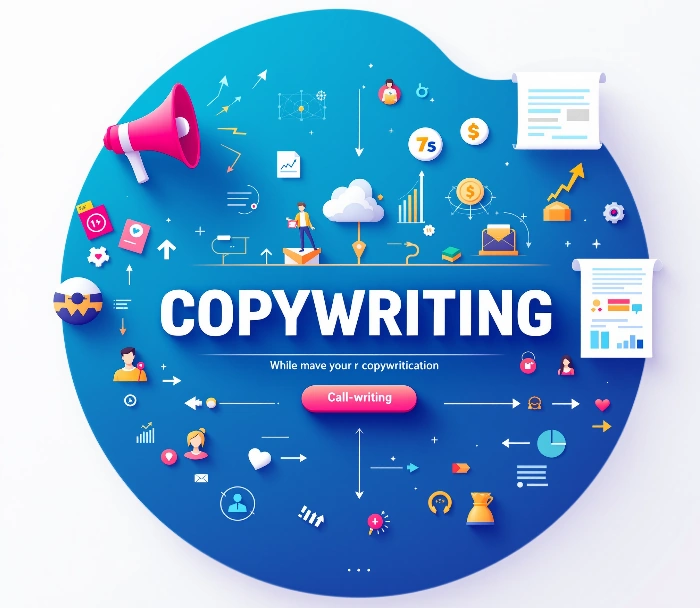Copywriting means crafting words that persuade readers to take action. This essential marketing skill transforms ordinary text into powerful messages that drive sales and conversions. Every successful business relies on effective copywriting to connect with customers and communicate value. Understanding what copywriting means can transform your marketing approach and dramatically improve your results.
The evolution of copywriting
Copywriting began in print media during the late 19th century. Early advertisers discovered the power of persuasive text in newspaper ads and mail-order catalogs. These pioneers developed techniques that still work today.
The advertising boom of the 1950s and 1960s elevated copywriting to an art form. Legendary copywriters like David Ogilvy and Claude Hopkins created campaigns that revolutionized how businesses communicated with consumers. Their work established core principles that modern copywriters still follow.
Digital transformation has expanded copywriting beyond traditional media. Today’s copywriters create content for websites, emails, social media, and digital ads. The fundamental goal remains unchanged: persuade readers to take specific actions.
Despite technological changes, human psychology stays consistent. Great copywriting taps into timeless motivations, desires, and pain points. The platforms evolve, but effective persuasion techniques endure.
Recommended reading:
- Perfect learning path to mastery Copywriting
- Copywriting freelance salary from beginner to expert
- Copywriting beginner 10 simple steps to Master the essential
Types of copywriting you should know
Direct response copywriting focuses on generating immediate action. This type creates urgency and includes clear calls to action. Sales letters, promotional emails, and landing pages typically use this approach.
Brand copywriting builds recognition and establishes voice. This style creates emotional connections rather than pushing for immediate sales. Taglines, mission statements, and about pages use brand copywriting techniques.
SEO copywriting balances search engine requirements with persuasive content. Writers must include keywords while maintaining reader engagement. This specialized skill helps content rank higher in search results.
Technical copywriting explains complex products or services. Writers translate difficult concepts into understandable language. Software companies, healthcare providers, and financial services rely on technical copywriters.
Email copywriting drives opens, clicks, and conversions. This specialized form combines attention-grabbing subject lines with persuasive body content. Effective email copy creates relationships and moves readers toward purchases.
Core principles that define what copywriting means
Audience understanding forms the foundation of effective copywriting. Writers must know reader demographics, pain points, desires, and objections. This knowledge shapes every word choice and argument presented.
Benefit-focused messaging highlights what customers gain. Strong copy emphasizes solutions rather than features. When readers understand how products improve their lives, they become more likely to purchase.
Clarity trumps cleverness in professional copywriting. Messages must communicate instantly without causing confusion. Simple language and direct statements create more impact than complex vocabulary or intricate phrasing.
Emotional connection drives purchasing decisions. Effective copy taps into feelings like fear, desire, pride, or security. These emotional triggers often prove more persuasive than logical arguments alone.
Social proof reinforces claims through testimonials and examples. Copywriters include evidence showing others benefit from the product. This reduces perceived risk and increases reader confidence in making purchases.
Essential skills for effective copywriters
Research abilities separate average writers from exceptional copywriters. The best practitioners investigate products thoroughly before writing. They also study competitors, audience segments, and industry trends.
Clear writing eliminates confusion and maintains attention. Copywriters master sentence structure, grammar, and word choice. They remove unnecessary content that dilutes their message.
Psychology knowledge enables targeted persuasion. Copywriters understand cognitive biases and decision-making patterns. This insight helps them craft messages that align with natural thinking processes.
Creativity helps copywriters capture attention in crowded markets. Original approaches stand out from typical advertising. Fresh perspectives make readers stop and consider the message.
Testing and optimization skills improve results over time. Great copywriters track performance and refine their approach. They understand which elements drive conversions and continuously improve their work.
The copywriting process explained
Research forms the starting point for every copywriting project. Writers gather information about products, audiences, and competitors. This foundation ensures messages resonate with target readers.
Outlining organizes key points before writing begins. Copywriters determine their persuasion strategy and content structure. This planning stage prevents missing important elements during creation.
Writing the first draft focuses on getting ideas onto the page. Copywriters develop their central arguments and supporting points. They implement techniques appropriate for their specific project goals.
Editing transforms rough content into polished copy. Writers eliminate unnecessary words and strengthen weak sections. This crucial step improves clarity and persuasive impact.
Testing different versions reveals what resonates most effectively. Professional copywriters create variations and track performance metrics. Data guides refinement and improves future projects.
Powerful copywriting techniques and formulas
The AIDA formula guides readers through four stages: Attention, Interest, Desire, and Action. Copywriters first capture notice, then build engagement, create wanting, and prompt specific behaviors. This structure creates natural persuasion flow.
Problem-Agitate-Solve (PAS) starts by identifying reader challenges. Writers then emphasize negative consequences before presenting solutions. This approach taps into pain avoidance motivation.
Features-Advantages-Benefits (FAB) connects product attributes to reader outcomes. Copywriters list features, explain their advantages, and highlight resulting benefits. This technique transforms technical details into compelling reasons to buy.
Future pacing helps readers visualize success after purchase. Copywriters create detailed pictures of improved circumstances. This mental imagery strengthens desire and overcomes hesitation.
Storytelling engages readers through narrative structures. Copywriters use characters, conflict, and resolution to illustrate points. Stories create emotional investment that factual statements alone cannot achieve.
Examples of exceptional copywriting in action
Apple’s famous “Think Different” campaign celebrated creativity and innovation. The copy associated the brand with visionary thinking through simple language. This approach built emotional connection without technical specifications.
Nike’s “Just Do It” tagline demonstrates powerful brevity in copywriting. These three words communicate determination, action, and personal achievement. The message transcends specific products to represent brand values.
Dollar Shave Club launched with humorous, conversational copy. Their approach broke industry norms with direct, informal language. This distinctive voice helped the startup compete against established giants.
Mailchimp maintains consistent brand voice across all content. Their playful yet professional tone creates recognition and trust. This consistency demonstrates how copywriting means establishing unique brand identity.
Airbnb’s “Belong Anywhere” campaign used aspirational copywriting. Their messaging focused on experiences rather than accommodations. This emotional approach transformed how consumers viewed travel possibilities.
How to improve your copywriting skills
Read widely outside your industry to expand your perspective. Great copywriters study successful examples across various fields. This broader exposure sparks creative approaches to common challenges.
Practice regularly with different copywriting formats. Write headlines, emails, product descriptions, and landing pages. Regular creation builds skill faster than passive learning alone.
Study consumer psychology through books and courses. Understanding why people make decisions improves persuasive ability. This knowledge helps you craft messages that align with natural thinking patterns.
Request feedback from colleagues and target audiences. External perspectives reveal blind spots in your writing. Constructive criticism highlights areas for improvement you might otherwise miss.
Analyze campaigns that successfully captured your attention. Identify specific elements that made these messages effective. Adapt these techniques to your own projects while maintaining originality.
The business impact of quality copywriting
Conversion rate improvements directly affect revenue. Effective copywriting turns more visitors into customers. Even small percentage increases can substantially boost business results.
Brand perception shapes customer relationships beyond individual purchases. Consistent, quality copywriting builds recognition and trust. This long-term asset creates customer loyalty and word-of-mouth promotion.
Customer education reduces support costs and improves satisfaction. Clear copywriting helps users understand products before buying. This prevents disappointment and returns while increasing positive experiences.
Search engine visibility increases when copywriting incorporates SEO best practices. Higher rankings bring more potential customers to your content. This expanded reach multiplies opportunities for conversion.
Marketing efficiency improves with message clarity and testing. Effective copywriting reduces wasted advertising spend. Companies achieve better results without increasing their marketing budget.
Common copywriting mistakes to avoid
Focusing on features instead of benefits confuses potential customers. Many businesses list technical specifications without explaining their value. Effective copywriting means translating features into meaningful advantages.
Writing for everyone results in connecting with no one. Generic messages fail to address specific audience needs. Targeted copywriting speaks directly to defined reader segments.
Ignoring customer language creates unnecessary barriers. Industry jargon often confuses rather than impresses readers. Successful copywriters use terms their audience naturally understands.
Neglecting calls to action leaves readers without clear direction. Many writers explain products without requesting specific responses. Complete copywriting always guides readers toward next steps.
Overlooking editing and testing limits potential effectiveness. Rough drafts rarely perform optimally without refinement. Professional copywriting includes systematic improvement processes.
Copywriting for different platforms
Website copywriting balances multiple objectives simultaneously. Writers must engage visitors, explain offerings, and encourage specific actions. Navigation labels, page headlines, and button text require careful consideration.
Social media platforms each demand unique approaches. Twitter requires brevity while Instagram supports longer narratives with visuals. Effective copywriters adapt their style to platform constraints.
Email marketing succeeds through relevance and timing. Copy must justify inbox space and prompt immediate reading. Subject lines deserve particular attention as gatekeepers to your message.
Print advertising maintains importance despite digital growth. Physical materials provide tangible connections with readers. Copywriters consider how print environments affect message reception.
Video scripts require writing for both ear and eye. Copywriters create spoken content that complements visual elements. This coordination creates memorable messages that viewers retain.
Copywriting for different industries
E-commerce copywriting focuses on product benefits and purchase facilitation. Writers must overcome objections without in-person salespeople. Product descriptions convert browsers into buyers through compelling language.
SaaS companies need copywriting that simplifies complex offerings. Writers explain technical capabilities through benefit-centered messaging. Effective copy helps prospects understand value without confusion.
Healthcare communication requires empathy and credibility. Copywriters balance emotional understanding with factual accuracy. This delicate combination builds trust while motivating action.
Financial services copywriting addresses security concerns and complex topics. Writers transform intimidating subjects into approachable information. Clear explanations remove barriers to engagement.
Nonprofit organizations use copywriting to inspire support and action. Writers connect donors with meaningful impact opportunities. Emotional storytelling plays a crucial role in motivating contributions.
The future of copywriting
AI tools change how copywriters work but enhance rather than replace human creativity. Writers now use technology for research and initial drafts. The most effective approach combines artificial and human intelligence.
Voice search optimization creates new requirements for natural language. Copywriters must anticipate conversational queries and provide direct answers. This shift influences content structure and keyword strategies.
Video content growth expands copywriting into scriptwriting territory. Writers create content designed for viewers rather than readers. This visual emphasis requires adaptation of traditional techniques.
Personalization technology enables dynamic content tailored to individuals. Copywriters now create modular content that adjusts to reader characteristics. This customization increases relevance and engagement.
Data-driven optimization improves copywriting effectiveness continuously. Writers track performance metrics to refine their approach. This scientific perspective complements creative skills.
Conclusion
Copywriting means connecting businesses with customers through persuasive communication. This essential skill transforms features into benefits and hesitation into action. Every successful marketing campaign relies on effective copywriting fundamentals.
The principles that make copywriting effective remain consistent despite changing technology. Understanding audience needs, communicating benefits clearly, and prompting specific actions drive results across all platforms and industries.
Developing your copywriting skills creates valuable business advantages. Whether you write your own content or hire professionals, recognizing what makes copy effective improves marketing outcomes. The investment in quality copywriting consistently delivers strong returns.
Remember that copywriting means more than just writing well. It combines psychology, marketing strategy, and creative communication. This powerful combination drives business growth through words that persuade and convert.

